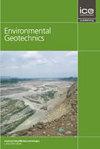土壤的水力和热力特性在蒸发中的作用:数值分析
IF 2.2
4区 工程技术
Q3 ENGINEERING, GEOLOGICAL
引用次数: 0
摘要
地质构造的蒸发是地质物质与大气相互作用的结果。岩土工程问题,如边坡稳定性、污染控制和土壤隆起/收缩,需要深入了解蒸发引起的土壤-大气相互作用。蒸发是一种多相热工水力学现象,包括液态水、蒸汽和热通量。它通常是考虑非饱和土壤的热能和水质量平衡方程进行建模的。本文提出了一个在受控环境条件下重现蒸发过程的数值模型。该模型在Comsol Multiphysics有限元软件中实现,并首次根据文献中的实验数据进行验证。然后,利用它来研究水力和热特性在蒸发响应中的作用。数值结果显示,由于水力传导率和截留性能之间的相互作用,含水量剖面随时间的演变存在差异。导水率主要影响含水量等时线的形状:随着导水率值的降低,表层快速干燥,深层缓慢去饱和。另一方面,含水量主要影响去饱和层的厚度,该厚度随着含水量的增加而减小。本文章由计算机程序翻译,如有差异,请以英文原文为准。
The role of hydraulic and thermal properties of soil in evaporation: a numerical insight
Evaporation from geological formations results from the interaction between the geomaterial and the atmosphere. Geotechnical engineering issues, such as slope stability, pollution containment and soil heave/shrinkage, require a deep understanding of the soil–atmosphere interaction ruled by evaporation. Evaporation is a multiphase thermo-hydraulic phenomenon that includes liquid water, vapour and heat fluxes. It is generally modelled considering the thermal energy and water mass balance equations of unsaturated soils. This paper presents a numerical model for reproducing evaporation processes under controlled environmental conditions. The model was implemented in the Comsol Multiphysics finite-element software and first validated against experimental data from the literature. Then, it was used to investigate the role of hydraulic and thermal properties in the evaporative response. The numerical results revealed differences in the evolution of the water content profiles over time due to the interplay between hydraulic conductivity and retention properties. Hydraulic conductivity mainly impacts the shape of water content isochrones: fast drying of superficial layers and slow desaturation of deeper layers occur with decreasing hydraulic conductivity values. On the other hand, the moisture capacity primarily impacts the thickness of the desaturating layer, which decreases for higher values of the moisture capacity.
求助全文
通过发布文献求助,成功后即可免费获取论文全文。
去求助
来源期刊

Environmental geotechnics
Environmental Science-Water Science and Technology
CiteScore
6.20
自引率
18.20%
发文量
53
期刊介绍:
In 21st century living, engineers and researchers need to deal with growing problems related to climate change, oil and water storage, handling, storage and disposal of toxic and hazardous wastes, remediation of contaminated sites, sustainable development and energy derived from the ground.
Environmental Geotechnics aims to disseminate knowledge and provides a fresh perspective regarding the basic concepts, theory, techniques and field applicability of innovative testing and analysis methodologies and engineering practices in geoenvironmental engineering.
The journal''s Editor in Chief is a Member of the Committee on Publication Ethics.
All relevant papers are carefully considered, vetted by a distinguished team of international experts and rapidly published. Full research papers, short communications and comprehensive review articles are published under the following broad subject categories:
geochemistry and geohydrology,
soil and rock physics, biological processes in soil, soil-atmosphere interaction,
electrical, electromagnetic and thermal characteristics of porous media,
waste management, utilization of wastes, multiphase science, landslide wasting,
soil and water conservation,
sensor development and applications,
the impact of climatic changes on geoenvironmental, geothermal/ground-source energy, carbon sequestration, oil and gas extraction techniques,
uncertainty, reliability and risk, monitoring and forensic geotechnics.
 求助内容:
求助内容: 应助结果提醒方式:
应助结果提醒方式:


